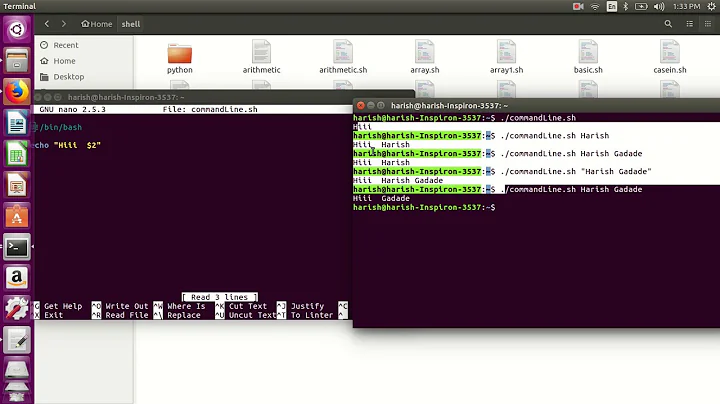"dash" arguments to shell scripts
Solution 1
There's the getopts standard (builtin) utility in POSIX shells for parsing command line arguments.
You can use this template:
#! /bin/sh -
PROGNAME=$0
usage() {
cat << EOF >&2
Usage: $PROGNAME [-v] [-d <dir>] [-f <file>]
-f <file>: ...
-d <dir>: ...
-v: ...
EOF
exit 1
}
dir=default_dir file=default_file verbose_level=0
while getopts d:f:v o; do
case $o in
(f) file=$OPTARG;;
(d) dir=$OPTARG;;
(v) verbose_level=$((verbose_level + 1));;
(*) usage
esac
done
shift "$((OPTIND - 1))"
echo Remaining arguments: "$@"
That parses the arguments in the standard way, like other standard commands would. for instance, you can call it as:
myscript -vvv -f file -d dir other arg
myscript -ffile -ddir -- other arg
See the POSIX specification or your shell manual for details.
Solution 2
#!/bin/bash
myfile=''
mydir=''
parse_args() {
case "$1" in
-d)
mydir="$2"
;;
-f)
myfile="$2"
;;
*)
echo "Unknown or badly placed parameter '$1'." 1>&2
exit 1
;;
esac
}
while [[ "$#" -ge 2 ]]; do
parse_args "$1" "$2"
shift; shift
done
Related videos on Youtube
JMJ
Updated on September 18, 2022Comments
-
 JMJ almost 2 years
JMJ almost 2 yearsMost shell scripts I use have syntax like
./shellscript.sh -first_argument_flag <first_argument_value> -second_argument_flag <second_argument_value>but all of the online resources for shell scripters only discuss passing positional arguments like
./shellscript.sh <first_argument_value> <second_argument_value>which are subsequently used in the script as
"$1","$2", etc.I would like to use the first, more user-friendly syntax rather than the positional argument syntax. As an example, suppose I want to echo a filename with flag -f and a directory with flag -d. Call this script echofd.sh. I want
./echofd.sh -f myfile.txt -d /my/directory/to produce the output
Your File is: myfile.txt
Your Directory is: /my/directory/
and regardless of which order -f and -d are positioned in calling the script.
-
 Admin over 7 yearsMost people use
Admin over 7 yearsMost people usegetopts(orgetopt) to do this, and this topic has been discussed several times.
-






